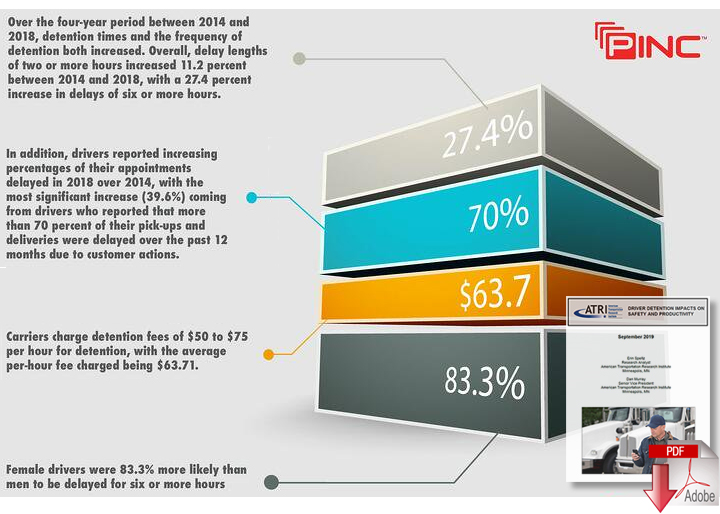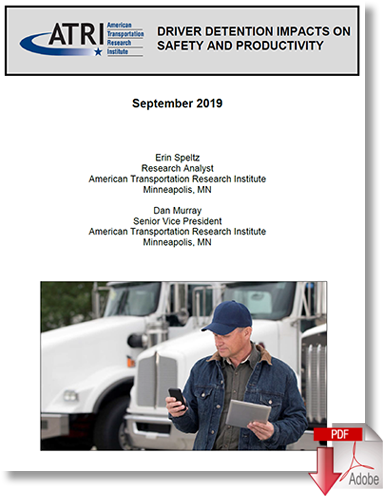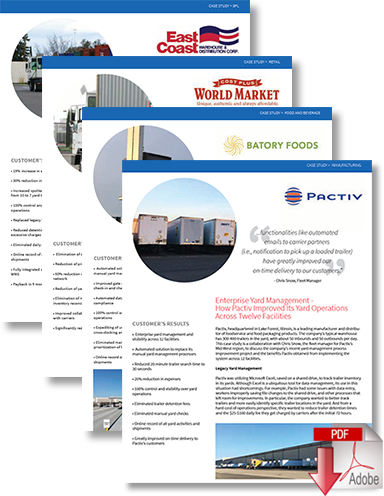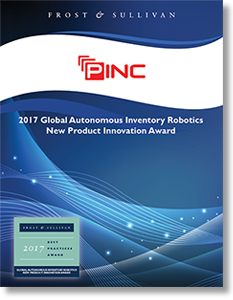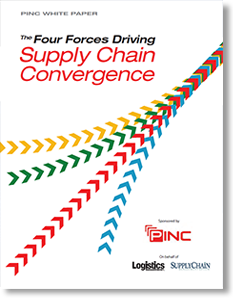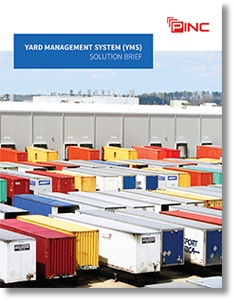10 Things to Know About Truck Driver Detention

Here’s how those hours that drivers spend waiting around the yard can impact the trucking industry, and what shippers, customers, and carriers can do about it.
The American Transportation Research Institute (ATRI) released the results of a new analysis on the safety and productivity impacts of truck driver detention at customer facilities.
The analysis is based on over 1,900 truck driver and motor carrier surveys conducted in 2014 and 2018.
The Transportation Chain
When a truck driver’s route is delayed at origin or pickup, that interruption can cause a trickle-down effect across the entire transportation chain.
Say, for example, a driver is nearing the end of his hours of service (HOS) limit as he pulls his tractor-trailer into the yard.
Within a few minutes, he learns that there are no loading docks free at the moment and that he’ll have to wait for one to open up.
If that driver waits for more than two hours, the driver detention fees will start to kick in for the company that held him up.
This can turn into an even bigger problem for the driver who has been behind the wheel all day and is now coming up on the maximum 14 hours he can work in the course of a day (truckers can only drive 11 total hours a day).
With the electronic logging device (ELD) now in full effect, there’s very little a driver or carrier can do but wait it out.
But wait, there’s more: if that driver does wind up with enough time to climb back into his cab and get moving to the next drop-off point, he may be tired or rushed behind the wheel - either or both of which can quickly turn into potential safety hazards.
This can create serious implications for shippers and their customers, and the situation is only exacerbating.
10 Things to Know About Driver Detention
According to a new report from the American Transportation Research Institute (ATRI), the frequency and length of time that drivers have been detained at customer facilities have both increased over the last four years.
Here are 10 things the ATRI wants you to know about driver detention:
- While there is no industry-standard definition of “excessive detention,” in Driver Detention Impacts on Safety and Productivity, ATRI says that it’s generally accepted within the trucking industry that any delay over two hours is reasonably defined as excessive.
- Carriers charge detention fees of $50 to $75 per hour for detention, with the average per-hour fee charged being $63.71.
- Significant detention times at shipping and receiving facilities can create a number of challenges for trucking operations, including interruptions to otherwise tight schedules and inefficient use of equipment and labor.
- Over the four-year period between 2014 and 2018, detention times and the frequency of detention both increased. Overall, delay lengths of two or more hours increased 11.2 percent between 2014 and 2018, with a 27.4 percent increase in delays of six or more hours.
- In addition, drivers reported increasing percentages of their appointments delayed in 2018 over 2014, with the most significant increase (39.6%) coming from drivers who reported that more than 70 percent of their pick-ups and deliveries were delayed over the past 12 months due to customer actions.
- When drivers are impacted by a delay at a shipping or receiving facility they may, in turn, be more likely to drive faster, take greater risks, or operate outside of their allotted hours in order to recover lost time and revenue associated with the detention.
- Most drivers have been in situations where they ran out of available HOS at a customer facility due to detention, and complain that detention can significantly impact their ability to comply with the HOS rules.
- Many shippers are unaware of the frequency and duration of driver detention, with some shippers and receivers purposefully creating “truck” queues at their facilities to ensure that truck capacity is readily available to support shipper operations.
- According to ATRI, almost one in five drivers complained that their preloaded trucks were not ready by the time of their appointment, products were not ready or were still being manufactured. Other culprits included overbooking appointments, booking more trucks than there are space/docks, and not having enough equipment to load and unload trucks.
- When drivers are detained at a customer facility they are losing on-duty, revenue-generating time. In fact, facility delays are the top factor identified by motor carriers in ATRI’s survey as impacting drivers’ ability to comply with HOS regulations (followed closely by customer pick-up and delivery requirements).
Not Pocket Change
According to ATRI, the drivers and carriers it surveyed for the report offered some key practices that they believe improve efficiency and minimize detention delays. Respondents noted that customers who were well organized, utilized technology, maintained tightly managed schedules and appointments, and/or utilized as-needed extended business hours (i.e., after-hours delivery), for example, greatly reduced delays. Other suggested solutions include the use of drop-and-hook operations, having the product ready on time, and having higher levels of empathy for drivers - and better communication with them.
“Lengthy loading dock wait times have plagued the trucking industry for years, with serious consequences for drivers and shippers alike,” Mona McFadden writes in The Secret to Combatting the Hidden Costs of Detention Time, noting that detention time affects driver efficiency, shipping capacity, and safety, with a negative financial impact for all stakeholders.
Digital Yard Management System to the Rescue
As one of the world’s largest producers of food packaging and disposable dinnerware, Pactiv not only supplies food processors, but it also supplies products to the foodservice industry (such as Sysco, US Foods) and consumer brands (Walmart, Sam’s Club). Up until recently, the company had very little visibility over its yard processes.
Responsible for the flow of product, and ensuring that all spotters and shuttle drivers are operating as efficiently as possible, Chris Snow, Midwest Fleet Manager says the company’s yard management approach presented numerous challenges for Pactiv. Individuals often forgot to “update” the software, or neglected to save it to the shared drive.
“Spotters would get out into the yard and spend 15 to 20 minutes looking for a trailer that we needed to unload or load quickly,” says Snow. And with 200 to 300 trailers in Pactiv’s yard at any given time, those 15- to 20-minute increments could quickly add up to hours wasted every day.
Pactiv was also challenged by high inbound trailer detention fees, namely because carrier trailers weren’t always unloaded in a timely fashion. “After three days, the carriers would start charging us trailer detention fees,” says Snow. “ldquo;If you’re talking about a week, that’s an extra $100 right off the top. If you’re not keeping a close eye on it, that total can grow pretty quickly.”
Since implementing it's Digital YMS, Pactiv has been able to reduce its spotting labor force by 20%, reduce the number of people needed to “shuttle” drivers back and forth between its manufacturing plants and distribution centers, and gained complete visibility over its yard operations.
Using its yard management system, Pactiv has a full map of its yard and identification of every trailer in that yard. These new levels of visibility are saving Pactiv money and time on several fronts. For example, trailer detention charges have been almost eliminated, says Snow, “and functionalities like automated emails to carrier partners (i.e., notification to pick up a loaded trailer) have greatly improved our on-time delivery to our customers.”
Related Article Transportation Trends: Critical Issues in the Trucking Industry
Related Resources
PINC Yard Management Systems: 4 Case Studies
In these 4 Yard Management System case studies, we detail how Pactiv, Batory Foods, Cost Plus Worl Market, and East Coast Warehouse & Distribution Corp. implemented PINC's Yard Management solutions to increase productivity, reduce expenses, eliminated trailer detention fees, and maintain control and visibility over yard operations, and more. Download Now!
The Rise of the Digital Yard
In this white paper, we explore the rise of the digital yard and show how technology is enabling significant efficiencies, productivity gains, and cost containment in a world where every penny added to the bottom line positively impacts organizational success. Download Now!
Global Autonomous Inventory Robotics New Product Innovation Award
This best practices research paper details the PINC Air inventory robotics solution with its quick deployment model, faster inventory velocity, product ingenuity, and rapid ROI underscoring the decision for PINC to win Frost & Sullivan’s 2017 New Product Innovation Award. Download Now!
The Four Forces Driving Supply Chain Innovation
When supply chain professionals discuss supply chain execution, their focus is typically put on transportation management systems and warehouse management systems, the yard management systems capability and importance is mistakenly undervalued. Download Now!
Solution Brief: Yard Management System
Yards are the intersection between warehouses and transportation, they are a critical linkage in logistics management practices and have a significant impact on the overall efficiency of the supply chain. Download Now!
More PINC Resources
Article Topics
PINC News & Resources
Transport Analytics for Enterprise Rail Visibility Mobile Device Procurement, Service, and Support for Industrial & Finished Goods Shippers Merger of Best-in-Class Supply Chain Companies PINC, ShipXpress, and RailCarRX Providing Enhanced Yard Management Services and Solutions to Enterprise Customers 2020 State of Yard Management Report: Identifying a Truckload of Savings Across Your Network The Impact of Digital Yard Management on Enterprise Transportation Costs and Capacity The Increasing Demand for Digital Yard Management Systems More PINCLatest in Transportation
A Look at Baltimore’s Key Bridge Collapse—One Month Later Baltimore Continues Bridge Recovery With Opening of New Channel How Shippers Can Prep for Hurricane Season UPS Struggles in First Quarter With Steep Earnings Decline FedEx Announces Plans to Shut Down Four Facilities The Two Most Important Factors in Last-Mile Delivery Most Companies Unprepared For Supply Chain Emergency More Transportation

